Essential GoPro Mounts for Kitesurfing: A Detailed Guide
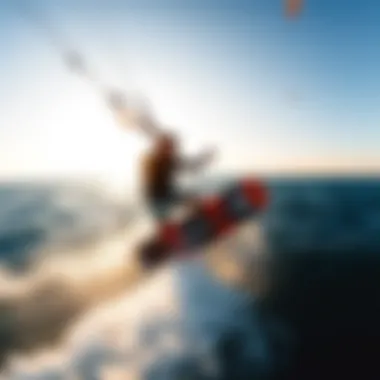
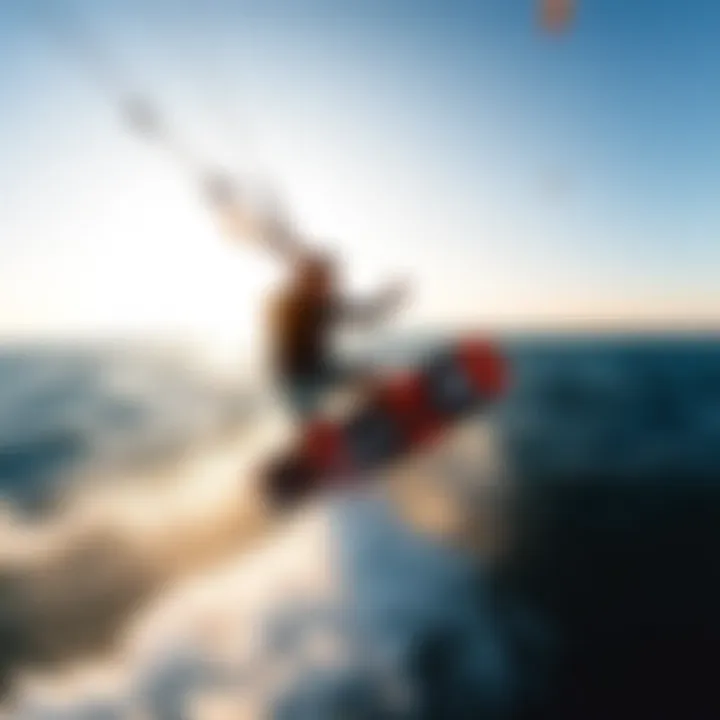
Intro
Kitesurfing is more than just a sport; it's an exhilarating way to connect with nature and push the boundaries of personal achievement. Documenting the thrills, spills, and breathtaking vistas that come with riding the wind and waves can take your experience to the next level. To capture those heart-pounding moments, GoPro mounts have become an essential piece of equipment for kitesurfers. There’s a variety of mounts available, each positioned to cater to different angles, styles, and safety considerations. This guide aims to walk you through the types of GoPro mounts that are particularly effective for kitesurfing, examining their unique features, benefits, and potential pitfalls, ensuring that both rookies and seasoned riders can film their adventures with style and ease.
With the right gear and knowledge in hand, your kitesurfing footage can truly shine, whether you’re looking to share online or simply reminisce about your personal escapades. Let’s dive into the nuts and bolts of these mounts, exploring what makes each option special while providing practical tips to optimize your filming experience.
Equipment Insights
Latest Gear Reviews
When it comes to GoPro mounts for kitesurfing, the world is your oyster. Products like the GoPro Hero10, with its built-in horizon leveling, have caught the attention of many kiteboarders. But it’s the mounts that play an outsized role in how your footage turns out. Here are some notable options:
- Helmet Mount: Perfect for capturing the rider's perspective, giving viewers a front-row seat to the action. However, the wind noise can be problematic. Be sure to use an external microphone or plan for good audio during post-editing.
- Chest Mount: Offers a stable and immersive shot while freeing your hands. Great for showcasing your kite control. One downside? It might obstruct your harness, affecting your ride.
- Board Mount: This one allows you to attach your GoPro directly to your board. It provides a unique view of the water splashing and the kite overhead. Just keep in mind that it’s lower to the water, so waves can hide some of the action.
While picking gear, think about how each mount will impact your filming style.
Essential Gear Maintenance
Taking care of your GoPro mounts and accessories is vital for consistent performance. Given the stresses that come with kitesurfing—saltwater exposure, sand, and UV rays—here are some quick tips to keep your gear in tip-top shape:
- Rinse After Use: After each kitesurfing session, give your mounts a rinse with fresh water. This helps remove salt and sand, preventing corrosion and build-up.
- Inspect Regularly: Check for wear and tear, particularly on straps or adhesive mounts. If something feels off, it's better to replace it before your next ride.
- Storage: Keep your equipment in a cool, dry place, and avoid leaving mounts in direct sunlight. When not in use, it’s best to store them in a padded case to prevent any physical damage.
By incorporating these practices into your routine, you won’t just preserve your investment; you’ll ensure that every ride is captured just as you remember it.
"High-quality footage often boils down to how well you maintain your equipment."
In the upcoming sections, we’ll cover techniques for optimizing those mounts while kitesurfing, helping you take your skills to the next level.
Prolusion to GoPro in Kitesurfing
Kitesurfing is not just a sport; it’s an exhilarating experience that combines the thrill of surfing with the freedom of flying. For many kiteboarders, documenting these breathtaking moments has become just as important as the ride itself. Enter the GoPro, a compact camera that has transformed the way enthusiasts capture their kitesurfing adventures.
Using a GoPro in kitesurfing allows riders to capture high-quality footage while they are in the middle of the action. This isn't just about showing off impressive tricks at a barbecue; it's about preserving memories and sharing them with fellow kiteboarders and enthusiasts. The unique angles and perspectives that GoPros provide can bring those moments back to life, offering an almost immersive experience for viewers.
From the powerful force of the wind lifting the kite to the splash of water as one lands a trick, these cameras can document the beauty and adrenaline of being out on the water. Moreover, for instructors, these videos serve a dual purpose of both showcasing taught skills and providing students with a visual aid for improvement.
However, having a GoPro alone doesn’t guarantee great footage. It’s vital to understand the different types of mounts available and how they affect the shooting angle, perspective, and ultimately, the quality of the videos captured. In a sport where the environment can be unpredictable, the right mount can secure the camera firmly in place, ensuring that each ride is documented without the risk of losing the equipment.
In kitesurfing, where the action can change in an instant, mounting the camera correctly is essential for crafting narratives that thrill viewers. Factors like wind direction and varying water conditions can vastly alter what is being recorded. Therefore, understanding the specific advantages of different mounts can empower riders and enhance their filming capabilities.
Ultimately, integrating GoPro technology into kitesurfing practices not only elevates personal experiences but also connects a broader community of enthusiasts through shared visuals. The ongoing evolution of GoPro mounts and cameras presents endless possibilities for creativity, making it vital for anyone serious about kitesurfing to explore what is available.
In summary, whether you're a seasoned pro or just starting, the GoPro is more than just a camera. It’s a tool that enhances the entire kitesurfing experience, allowing users to create engaging, high-quality footage that captures the essence of their adventures. The following sections will dive deeper into specific types of mounts, decision-making factors, and best practices for making the most out of these incredible devices.
The Significance of Video Documentation
In the realm of kitesurfing, video documentation holds a pivotal role, acting as a bridge between experience and expression. When a kitesurfer captures their session on film, they are not just preserving memories; they are laying down a rich tapestry of personal growth and skills honed over time.
Benefits of Video Documentation
- Skill Assessment: Watching your own videos can reveal nuances in your technique that might escape notice in the moment. A slight tilt in the shoulders or an awkward landing, for example, could surface during a review. This reflection enables riders to pinpoint areas needing improvement, fostering a continual growth mindset.
- Sharing Knowledge: Kitesurfers often operate in a community where shared experiences boost learning. By documenting sessions, an individual can share not only their successes but also their missteps. For newer riders and instructors alike, viewing real examples can provide invaluable insights into the sport's intricacies. For instance, a video showcasing effective kite handling can help someone struggling with downwind conditions.
- Personal Motivation: A recorded session encapsulates the emotional highs of riding, the thrill of perfect landings, or the sheer joy of conquering challenging conditions. When motivation wanes after a rough stretch, reviewing past footage can offer a much-needed boost, reminding riders of their capabilities and reigniting their enthusiasm for the sport.
Considerations in Video Documentation
However, documenting kitesurfing is not without its challenges. It’s essential to consider several factors:
- Quality of Footage: A shaky camera or poor angles can detract from the action. Investing in stable mounts and using proper settings on your camera can elevate the quality of video.
- Safety Concerns: Filming while kitesurfing introduces an element of risk, particularly if distractions arise from managing the camera equipment. Prioritizing safety while focusing on capturing footage is essential for both the rider and the cameraman.
- Editing Skills: The raw footage is just the tip of the iceberg. Learning how to edit videos effectively can transform average footage into something spectacular. Familiarity with editing software facilitates this process, allowing riders to showcase their best moments effortlessly.
"Capturing a moment is more than just turning a camera on. It's about framing experiences that can later inspire and inform."
Epilogue
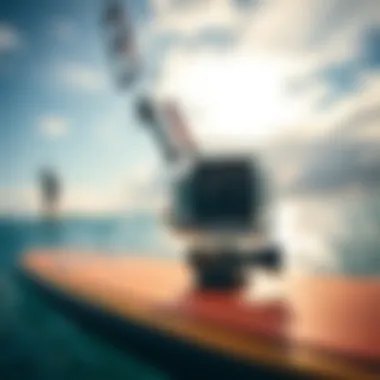
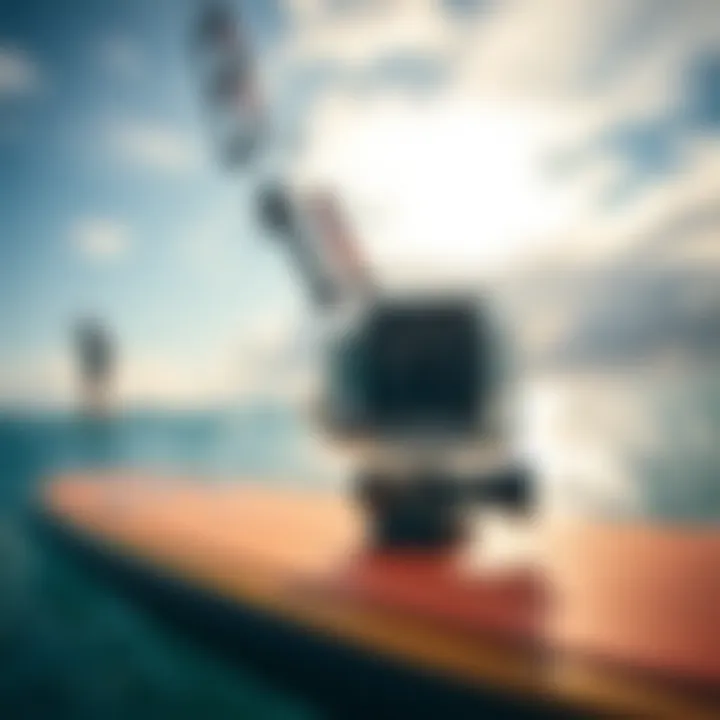
In summary, video documentation is not just a tool for ego; it's an integral aspect of kitesurfing that supports skill development, community learning, and personal motivation. As technology continues to improve, embracing this medium can elevate an individual's kitesurfing journey, making every session not just a ride on the waves but a chapter in an ongoing story.
Types of GoPro Mounts Available
When it comes to kitesurfing, having the right gear is crucial. Among those essentials, the choice of GoPro mount can dramatically change the way experiences are captured and shared. Using the correct mount can enhance the footage quality and keep it safe during the ride. This segment will explore the various GoPro mounts suitable for kitesurfing, detailing their unique advantages and considerations for those looking to document their adventures.
Chin Mounts
Chin mounts are a unique setup that attaches directly to the chin area of a helmet. This position provides a low angle shot, which often feels immersive, putting the viewer right in the action. Using a chin mount makes it easy to capture not just the beautiful scenery, but also the rider’s movements and reactions. However, it's worth remembering that it could limit the field of vision slightly compared to a higher mount, which might be a concern for some.
The upside? Misplacing the camera is less likely, making it stable through gusts of wind. It tends to work best in conditions where speed and agility play significant roles.
Helmet Mounts
A classic choice among kitesurfers is the helmet mount. This easily adjustable option gives a bird's-eye view of the rider's journey and provides versatility for different filming angles. Being atop the head, it captures the kitesurfer's actions while showcasing the surrounding vistas. Adding a secondary camera at a different position can further enhance the footage depth.
One donwside is the potential for turbulence, which can shake the footage a bit if not securely adjusted. It’s vital to make sure the mount does not obstruct peripheral vision or become a distraction while riding.
Chest Mounts
Chest mounts encourage a unique perspective, allowing viewers to see exactly what the kitesurfer is experiencing, giving emphasis to the rider's movements and interactions with the board and kite. This mount tends to be lower to the ground, offering a slightly different angle that can highlight the board and kites’ interaction with the waves.
The chest mount’s location also helps reduce the chances of shaking footage compared to higher mounts. However, some may find it restricting in terms of movement, especially during intense tricks or jumps which could lead to awkward angles. It’s essential to evaluate personal comfort when considering this mount.
Wrist Mounts
Wrist mounts, as the name implies, are attached to the rider's wrist. They allow for a nimble and flexible way to shoot footage. This option can capture the kitesurfer's hands working with the controls of the kite as well as the action unfolding around them. However, one thing to keep in mind is the possible difficulty of aiming the camera precisely, which may lead to unexpected framing of shots.
These mounts are lightweight and can often be easily attached or removed, making them a solid option for those wanting to switch angles frequently. Despite this, they're not widely used for continuous footage since they may not capture the larger scene well unless coordinated precisely.
Board Mounts
Mounting a GoPro directly onto the board opens up a whole new angle of shooting. This method allows riders to showcase their unique style and interaction with the water. It captures that thrilling rush of gliding over waves and can even record close-up maneuvers that would otherwise remain unseen. However, a downside is that if the rider wipes out, the camera could sustain damage, so these mounts need to be secured properly.
Consider this: Many board mounts can capture the surf conditions and lend themselves well to editing by highlighting the transition of each ride. Just ensure the installation is secure to avoid any mishaps mid-ride.
Selfie Sticks
Selfie sticks can provide a more personal touch to kitesurfing videos. They allow the kitesurfer to angle the camera freely for stunning selfies mid-air or thrilling vertical shots. It’s a dynamic choice when trying to capture that perfect moment with the wind whipping through your hair.
However, be mindful of the environmental factors; the stick could become a hindrance if not used judiciously. Taking a moment to ensure that the rear grip remains steady while filming is essential to reducing blurriness. It’s advisable to secure the GoPro to your wrist as well for extra safety.
Drone Mounts
Finally, drone mounts provide an innovative way of enhancing visual storytelling for kitesurfing. They allow for sweeping overhead shots that can encapsulate not only the kitesurfer’s movements but also the vastness of the sea and sky. This perspective can make videos much more captivating.
Aiguing battery management and flying regulations are paramount. Pilots need to possess a solid understanding of the local laws around flying drones over water, as well. Just as crucially, it’s vital to ensure the drone’s footage syncs well with on-ground video to create a seamless viewing experience.
In summary, each mount offers a unique share of benefits and challenges that can significantly augment your kitesurfing footage. Choosing the right one largely comes down to personal preference, the style of riding, and how a rider wants to share their journey. Whether going for the adrenaline of a board mount or the versatility of a helmet mount, knowing the ins and outs of these options can profoundly enhance the overall kitesurfing experience.
Deciding Factors in Choosing a Mount
Choosing the right mount for your GoPro while kitesurfing goes far beyond merely picking a product off a shelf. The mount you select can significantly affect the quality of your footage and, ultimately, your enjoyment of the activity. Understanding the deciding factors helps you align your choice with your particular needs and goals, ensuring that your investment yields the best possible results.
Level of Experience
Your level of experience plays a crucial role in mount selection. Novices may find it simpler to use basic mounts that provide a stable perspective without requiring advanced setup. For instance, a chest mount could be a great starting point as it offers a relatively straightforward attachment point while capturing a rider's hands and the board all in one shot.
Conversely, seasoned kitesurfers might lean towards specialized mounts like chin or helmet mounts. These options provide a dynamic viewpoint and are often adjustable, allowing experienced users to experiment with angles and perspectives. Keep in mind that your familiarity with the equipment not only affects the choice of a mount but also how you adapt to various filming conditions.
Desired Footage Style
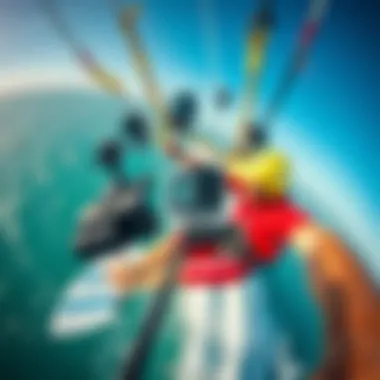
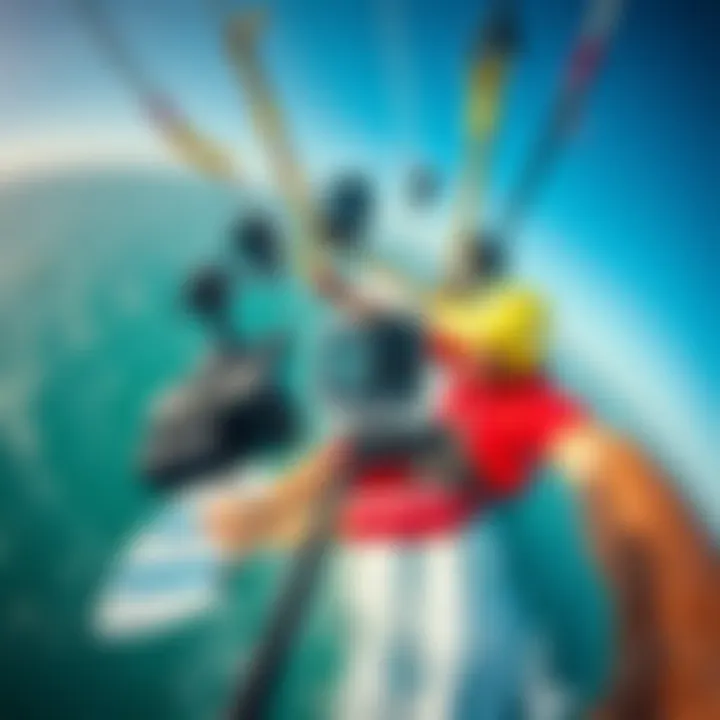
What visual story do you want your footage to tell? The answer to this question will guide much of your decision-making. If you're after a high-intensity, action-packed vibe, a helmet mount may be your best bet, providing a first-person perspective that conveys the thrill of cutting through waves and soaring through the air. This style resonates well with viewers who crave the adrenaline rush that kitesurfing offers.
On the flip side, if you prefer sweeping panoramas that showcase the beauty of your surroundings, a board mount might be ideal. These mounts set the camera low to the water, capturing not just your movements but also the stunning sights and colors of the ocean.
The choice of style affects not just aesthetics but also how you’ll need to set up and handle your GoPro during rides.
Type of Kitesurf Conditions
Let's face it: conditions during a kitesurfing session can vary, sometimes within the same day. Wind and water conditions are pivotal in choosing your mount. For rough conditions, stronger attachments or those designed for extreme angles should be prioritized to ensure stability. A solid mount like the board mount can withstand forceful winds and splashes, keeping your device secure.
However, on calmer days with lighter winds, flexing your creative muscles with a wrist mount or a handheld selfie stick might bear more fruit. These allow you to capture stunning angles that highlight not only your skills but also the vast beauty of the sea and sky.
Best Practices for Mounting
When it comes to capturing the thrill of kitesurfing, having the right mount is half the battle. But once you've selected a mount, how you position and adjust it can make all the difference in the world. Adhering to best practices for mounting not only enhances video quality but also ensures safety during your ride.
Optimal Positioning
Finding the right position for your GoPro mount can drastically impact the footage you capture. Each mounting location offers a unique perspective, but there are certain spots that are generally favored among those in the kitesurfing community.
Common Mounting Locations:
- Chin Mount: This typically provides a first-person view, showcasing your movements and reactions. It’s got a closer angle, capturing more of the rider's actions.
- Board Mount: Perfect for showing the connection between the rider and the board. You’ll capture the waves and your feet in action, which can be particularly thrilling.
- Wrist Mount: This allows for dynamic shots while you maneuver. You can twist your wrist to show various angles without losing sight of the horizon.
Initially, experiment with different positions to find what works best for your personal style and riding conditions. A mount that's nailed down in the right spot can tell a compelling story of your ride, pulling viewers into the experience of gliding over the water and catching the wind.
Adjusting Angle and Orientation
Once you know where to place your GoPro, the next step is adjusting the angle and orientation of the camera. This part is crucial; a comically angled shot can potentially ruin an epic moment.
Make sure you:
- Tilt the Camera: Keep it slightly tilted downward. Aiming too high might capture more sky than action. On the flip side, excessively low angles can miss the beautiful horizon.
- Check the Direction: If you’re planning to capture those daring jumps or tricks, face the camera towards the direction of your movement. This way, you won’t miss the thrill of soaring through the air or the splash upon landing.
- Test and Adjust: Like a good kite that requires tuning, so too does your camera need slight adjustments on the fly. Secure your camera but don’t be afraid to tweak the angle as the conditions change.
"Capturing action is like catching lightning in a bottle, only the right angle can make that spark shine."
Each position and adjustment you make provides not just footage, but an opportunity to share the rush of kitesurfing with others. It’s all about finding that sweet spot that matches your personal style while enabling you to express the adrenaline of your experience.
Safety Considerations
As kitesurfing involves high speeds and unpredictable conditions, ensuring safety while capturing your thrilling moments is paramount. Safety considerations encompass two primary facets: the security of the mount itself and the safety of the kitesurfer during filming. Addressing these can enhance not only your filming experience but also your overall kitesurfing journey.
Mount Security
When you're attached to a large piece of equipment, as with kitesurfing, the last thing you want is your camera mount giving out at the worst moment. Proper mount security means assessing not only the strength of the mount but also how well it adheres to your gear. Here are some factors to consider:
- Type of Adhesive: Many mounts utilize strong adhesives. Ensure you're using a mount designed for high-impact activities, as typical stickers can weaken in water or under sunlight.
- Safety Tethers: Consider using a safety tether. This little addition can save your expensive camera if the primary mount fails, keeping it attached to your harness or board.
- Regular Inspections: Before hitting the waves, inspect the mounts. Look for signs of wear and tear.
In sum, a securely mounted GoPro can resist the elements and the forces at play while you kitesurf, ensuring your equipment doesn’t become a liability.
Personal Safety While Filming
Filming yourself kitesurfing can be exhilarating, but it introduces specific risks that must not be overlooked. Understanding your surroundings and taking precautions is crucial. Here are some pointers for keeping both you and your camera safe:
- Awareness of Your Environment: Always be conscious of current conditions and how they may affect your filming. Be wary of other kitesurfers, boats, or any hazards in the water.
- Sufficient Gear: Make sure you wear appropriate safety gear, such as a helmet and impact vest. These can protect you in the event of a fall or collision.
- Communication: If you’re filming with friends or an instructor, make sure there is a method of communication. This could involve signal flags or calls, especially in crowded waters.
- Practice Makes Perfect: Try filming in calmer conditions before venturing into challenging aspects of kitesurfing. Getting comfortable with your mounting setup can make a significant differnce.
"Safety is not a gadget but a state of mind." This classic reminder rings true for anyone involved in extreme sports.
Editing and Sharing Kitesurfing Footage
Capturing high-octane moments while kitesurfing is essential, but what really sets great footage apart is how effectively it’s edited and shared. Editing is not just about cutting clips; it’s about telling a story. In kitesurfing, the thrill is in the ride, the wind, and the waves. These elements need to be woven seamlessly into a cohesive narrative that keeps viewers engaged and breathless. Without proper editing, even the most breathtaking shots can fall flat. The importance of this aspect cannot be overstated—it turns raw video into a polished gem.
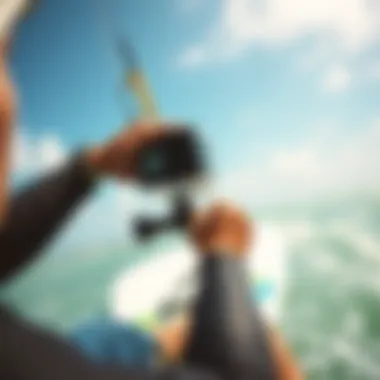
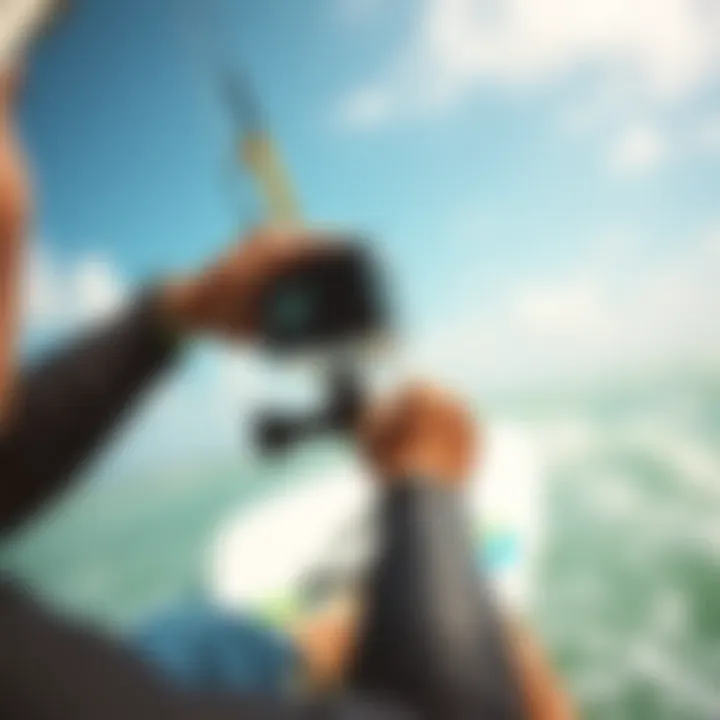
When it comes to sharing, select platforms can draw an audience that truly appreciates the art and adventure of kitesurfing. Each platform serves distinct demographics and purposes, shaping how your footage resonates with the world. Therefore, it’s important to know where to showcase your endeavors, whether it’s to draw in followers, get feedback, or simply share experiences with like-minded enthusiasts.
Software Recommendations
Editing software plays a crucial role in how your footage looks and feels. There are many options on the market, but finding the right fit for your needs and skill level is key. Here are some notable mentions:
- Adobe Premiere Pro: A staple for professionals, offering comprehensive tools for high-quality editing. It could seem daunting for a beginner, but it’s a solid investment in your creativity.
- Final Cut Pro: Loved by many Mac users, its intuitive interface makes it easier to get started while producing industry-standard visuals.
- DaVinci Resolve: This is a more affordable option that doesn’t skimp on features. It’s particularly good for color grading, giving your footage that ‘wow’ factor.
- iMovie: For those just starting out or needing something simpler, iMovie is user-friendly and perfect for basic edits, with options for adding music and effects.
- KineMaster: If you’re looking to edit on the go, this mobile app is neat, allowing quick edits right from your smartphone.
When choosing software, consider factors like your editing experience, the complexity of your edits, and budget. Take a moment to name the functionalities that matter most to you, whether it’s multi-track editing, easy export options, or advanced effects.
Sharing Platforms
Once your footage is edited to perfection, the next step is sharing it with the world. Different platforms can help you target specific viewers or showcase your work in varying manners:
- YouTube: The king of video sharing, allowing you to reach a vast audience. You can easily subscribe to channels and get feedback. Using correct tags and a catchy title will make your video more discoverable.
- Instagram: Best for visually appealing snippets. This platform thrives on beautiful imagery and quick engagement, making it a great place to show off highlights and connect with fellow kite enthusiasts through stories and IGTV.
- Facebook: An excellent platform for community building. Sharing your videos within kitesurfing groups can lead to constructive feedback and camaraderie.
- Vimeo: Known for a more art-focused community, it’s suitable for polished, visually striking content. This platform attracts a different audience—those looking for inspiration and high-quality production value.
- Reddit: Sharing your footage on subreddits related to kitesurfing can be a hit or a miss. It requires an understanding of community preferences, but when done correctly, it can drive interest and feedback.
These platforms vary not only in audience size but also in user engagement. Know your target viewers, and tailor your uploads accordingly for maximum impact.
"Editing is where magic happens, turning mere footage into a story that captures the heart of kitesurfing."
The Future of GoPro Technology in Kitesurfing
As the world of kitesurfing continues to evolve, so too does the technology behind capturing those exhilarating moments on the water. GoPro has been a cornerstone in the action camera industry, consistently innovating to keep up with the demands of adventurers and filmmakers alike. This evolution is pivotal for kitesurfers who want their experiences documented in the most vivid and engaging ways possible. In this section, we will explore upcoming trends and the potential benefits of advances in GoPro technology, particularly tailored for kitesurfing.
Developments in Camera Technology
The advancement of camera technology in devices like the GoPro is more than just an upgrade in pixels. Features such as improved stabilization, better low-light performance, and innovative lenses open new horizons in capturing kitesurfing footage.
- HyperSmooth Stabilization: This feature allows riders to document their sessions with fluid motion, minimizing jarring cuts even in the choppiest waters.
- Higher Resolution and Frame Rate: The capability to shoot in 4K at higher frame rates guarantees stunning visual fidelity, allowing users to slow down footage without losing clarity.
- Enhanced Durability: As kitesurfing is an extreme sport, GoPros are becoming even more streamlined against impacts, water, and sand. The ruggedness of these devices means that they can withstand the tough environment.
Integration with Smart Technology
As we delve deeper into smart technology, GoPros are integrating more seamlessly with other devices.
- Smartphone Connectivity: The intuitive link between GoPro cameras and smartphones permits on-the-fly editing and sharing. Imagine getting off the water and instantly uploading a highlight reel to social media without having to fuss with cables or external drives.
- Voice Control: The addition of voice commands provides convenience when you’re getting ready to launch or land your kite. A simple voice prompt lets you start or stop recording hands-free.
Immersive Features and Virtual Reality
Virtual reality (VR) is grabbing attention in a myriad of sports, including kitesurfing.
- 360-Degree Video: The production of immersive 360-degree videos allows viewers to experience the ride from the rider's perspective. This technology invites spectators to feel like they're right there alongside the kitesurfer, uplifting the storytelling aspect significantly.
- Augmented Reality Integration: Emerging AR capabilities could produce tailored overlays of stats, like speed or altitude, enhancing the viewer's experience during playback.
Recommendations for Future Use
For upcoming kitesurfing enthusiasts considering integrating GoPro technology into their adventure, it’s vital to stay abreast of upcoming models and features. Prioritize mounts that can effectively handle the upcoming standards in camera technology. Choose versatile mounts that adapt to the features of the new devices to guarantee comprehensive footage capture while you ride.
"Innovation drives the thrill; it's not just about the ride, but about how you capture it".
The End
In summary, the future of GoPro technology in kitesurfing shines brightly as new features emerge to enhance both the user experience and the quality of video documentation. Whether diving into the waves as a beginner or showing off tricks as a pro, understanding and utilizing the advancements in GoPro technology equips kitesurfers with the tools needed to capture their adventures like never before. Keeping an eye on these developments can help riders harness new capabilities for stunning footage that encapsulates the essence of kitesurfing.
Closure: Enhancing Your Kitesurfing Experience
In the exhilarating world of kitesurfing, the experiences are as vast as the ocean itself. Having a way to capture these moments through a GoPro mounts can truly elevate your journey on the water. As we've delved through various mounting options and considerations in this article, the essence of enhancing your kitesurfing experience comes down to several critical factors.
First off, the choice of mount significantly influences the perspective you get on your video recordings. Whether it is the exhilarating views captured from a board mount or the immersive angles provided by a chest or helmet mount, each option opens a unique window into the world around you. If you think about it, if a breathtaking jump or a graceful glide isn’t documented, did it really happen? In essence, it’s all about preserving those epic moments that bring the thrill of kitesurfing to life.
Secondly, understanding your environment shapes how effectively you can utilize your equipment. Kitesurfing conditions can vary remarkably—from tranquil lagoons to choppy seas. Recognizing these elements plays a major role in helping you choose the right GoPro mount that offers both security and the optimal angle for your recording needs. It’s like wearing the right shoes for a particular hike; the better prepared you are, the more you can enjoy the journey.
Moreover, one cannot stress enough the importance of safety while filming. A secure mount equals peace of mind. Knowing your GoPro is tight and secure allows you to focus fully on riding your kite, instead of worrying if your camera will survive the next big wave.
"In kitesurfing, every turn, jump, and wave counts. Each video brings you back to that moment, adding layers to your memory."
In addition, editing your footage can further enhance your overall experience. With the right software and editing techniques, you can transform your raw records into compelling stories that you and your friends will want to replay over and over again. Whether posted on social media or shared in friendly circles, your recordings can inspire others and solidify friendships based on shared passions.
For further exploration and tips on kitesurfing gear, you can check resources at Wikipedia or Britannica. To share your own kitesurfing adventures, visit platforms like Reddit or Facebook where the community thrives.







